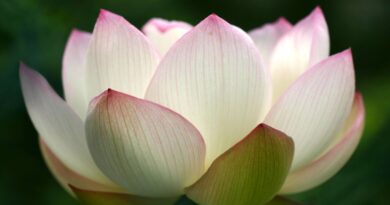HERE AND NOW – CHAPTER 3: AWAKE AND AWARE
It is important to experience and not to believe. In order to do that, we have to pay attention. In the famous and often quoted Kalama Sutta, the Buddha gives ten points which are not suitable as criteria to follow a teacher or a spiritual path. All of them have to do with a belief system because of traditional lineage or because of sacred books. Not to believe but to find out for ourselves is the often repeated injunction of the Buddha. Unless we do that, we cannot have an inner vision, which is the first step that takes us on to the noble path.
An inner vision is an understood experience. Without that, insight cannot arise. That holds true for small matters in daily life, just as it holds true for the deepest and most profound understanding of the Buddha’s teaching. If for instance somebody is not pleased with us and we don’t understand why, we shall have that same disharmony happen to us over and over again. We need to realize that we may have said or done something to cause that displeasure. This is a small matter showing the need for understanding an experience.
If we think these happenings are something outside of ourselves, we can’t change our attitudes. Practicing Dhamma means constantly changing ourselves to reach out towards the sublime. If change were not possible, the Buddha would have given a lifetime of teaching in vain.
Unless we pay total attention to every detail we’ll never change towards the sublime. Attention to detail is the core of mindfulness. Most people lack the practice and also the instructions to be truly mindful. It’s one thing to read about it, but an entirely different matter to do it. Mindfulness is the essence of understanding, because without it there is no seeing into the heart of any phenomena.
Watching the breath means “knowing exactly”. Mindfulness is not judgmental, nor discriminating, nor telling stories. Mindfulness knows when there is concentration and when there isn’t when the mind wanders off and when the mind becomes peaceful. Perfect mindfulness knows every moment that is occurring.
When we pay attention to our feelings and do not react to them but only observe, then we’re using the second foundation of mindfulness, //vedananupassana// (mindfulness of feeling). When we know we’re thinking, it’s //cittanupassana// (mindfulness of thought) and when we know what the content of the thought is, it’s //dhammanupassana// (mindfulness of mind objects). If we’re not paying attention, we’re not really awake. We need to practice clear attention to any one of these at all times.
It is possible that in meditation the mind becomes concentrated. If there is a feeling of peacefulness, one has to know that quite clearly. Without realizing what is happening, one cannot go further, because one doesn’t know where one is at. This is an important detail of meditation, knowing exactly what’s happening and being able to verbalize it after the occurrence. The verbalization is the understood experience, and occurs naturally after the experience. This holds true for any mind-state and for any feeling. The Dhamma is the Buddha’s verbalized experience. Unless we can do that with our own experiences, we are left with a belief system, which can dull the mind. But meditation is to sharpen the mind. The mindful mind is a sharpened axe, with a sharp and finely honed blade which can cut through all our illusions. When we sit in meditation, we can get to know the disturbances of our own mind: such as the dull mind that doesn’t know what’s going on, or the sleepy mind, the distracted or the resisting mind, that doesn’t want to obey. That is mindfulness of mind objects.
Like most human beings, we have a distracted mind, geared so much towards trying to resist the unpleasant and crave the pleasant, that this pattern is very difficult to change. If we find ourselves resisting the unpleasant, seeking the pleasant, we just know that this is a normal habit pattern. This is how this little spaceship earth operates, and how our economy works. Do you know anybody who’s blissfully happy because of it? It is an impossible venture, it is a guaranteed failure, yet everybody is still trying. We have all been trying long enough, we can give it up, at least for the time we’re meditation. However it is possible to get rid of //dukkha//, but not by eliminating the unpleasant sensations, only by getting rid of our reaction to them. This is the most important primary entrance into the spiritual path. Unless this is perfectly understood, the rest will not fall into place. We won’t get rid of the unpleasantness of sitting, or of mosquitoes, or of anything unpleasant we may encounter. All is mind-made and therefore mind-reacted. //Dukkha// disappears when our reactions disappear.
Unless we know that we are the creators of our own //dukkha//, Dhamma remains a mystery. We start practicing when we no longer blame our surroundings, other people, the political situation, the economy or the weather. We see only our own reactions. Naturally our reactions aren’t immediately going to be all favorable and wholesome. That will take a while. But at least we can start doing something about ourselves.
Mindfulness needs to be used not only in our meditation practice, but also every time we move, feel or think in our daily life. While awake, mindfulness has to be our primary objective. One has to come to terms with oneself. Only then will the world make sense one day. The universe is this mind and body. We find out what this mind and body are all about, and we kill know the universe and its underlying truth. All is distinctively the same, but we have to know what it is.
When we come out of meditation, we should be aware of opening our eyes, moving our body, of everything we are doing. Why? First of all, it will keep us from thinking unwholesome, negative thoughts. It facilitates meditation. The mind needs to be kept in check and not allowed to run wild. The ordinary, unpracticed mind is like a wild bull running around in a garden. It can make a mess of the garden in no time. That’s what our minds are doing. They’re making an awful mess of this world we live in. We don’t even have to read the newspapers to know about it. It’s to be seen everywhere, and comes from our own minds. All of us are included, except the enlightened ones. A wild mind can’t meditate. It has to be caught, kept in check, and a halter put on. Every time it runs away, we bring it back with mindfulness, like training a wild horse which in its wild state cannot benefit anyone. If the horse is tamed and trained it can be extremely useful. How much more this is true of the mind!
Mindfulness of the body means that we know the movements of all parts. As we watch ourselves, we will see that there is mind and body. The mind giving the orders, the body following suit. We can recognize too that sometimes the body can’t obey because it is weak. This is our first entrance into insight, realizing there are mind and body and the mind being the more important one. The difference between a trained and an untrained person it the understood experience.
Mindfulness which extends to the body movements extends to the other aspects of mindfulness as well. If, for instance, we are thinking about the future we are no longer paying attention to the body; instead we can pay attention to the thought process. We know that we are thinking, and are making kamma. The thoughts are the mental formations, as well as the kamma formations. We are the owners of our kamma. Whatever we think, that we will be. It’s an impersonal process which has nothing to do with any particular entity.
Then we can become aware of the content of our thoughts, which means knowing whether it is wholesome or not. We can learn to drop any negative thinking and replace it. This is where our meditation training comes in, which is not divorced from outer activities. When we pay attention to the breath in meditation and a thought intervenes, we learn to let go of the thought and come back to the breath. The same procedure is used in daily life to let go of unwholesome thoughts. We substitute at that time with a wholesome thought, just as we substitute with the breath in meditation.
Mindfulness of the thinking process is what the Buddha Named the “four supreme efforts.” [*] They constitute the heart of the purification process. The spiritual path is the path of purification and hinges on mindfulness. “There’s only one way for the purification of beings, for the overcoming of //dukkha//, for the final elimination of pain, grief and lamentation, for entering the noble path, for realizing Nibbana, that’s mindfulness.” (Words of the Buddha). To practice the purification process is necessary not only for one’s own peace of mind, for adding to the peace in the world, but also in order to be able to meditate.
* [The four supreme efforts (//padhana//) are: 1. To avoid unwholesome states of mind 2. To overcome unwholesome states of mind 3. To develop wholesome states of mind 4. To maintain wholesome states of mind.]
The hope that one might sit down on a pillow, watch the breath and become concentrated, is a myth. One has to have the mind in proper shape for it. Therefore, we must practice these four supreme efforts not only while we are meditating, but in every-day life. We will gain inner peace which everybody is looking for and very few people ever find.
The first effort is not to let an unwholesome thought arise which has not yet arisen. The requires sharp mindfulness. A thought which has not yet arisen creates waves ahead of it. To realize that these waves are boding no good, needs much attention and practice. The second effort, not to continue an unwholesome thought which has already arisen, can be done by anyone of good will, if it is understood that there is nobody else to blame. Unwholesome thinking is not due to outer triggers, but results strictly from our own defilements.
The third step is to make a wholesome thought arise which has not yet arisen. This means that we continually watch over our mind and encourage positive, wholesome thoughts where none are present even under the most trying circumstances.
Finally, to make a wholesome thought, which has already arisen, continue. In the meditation practice, this concerns our meditation subject. But in daily life it means our mind’s reaction. If we have some sensitivity towards ourselves, we can feel that there is a disturbance within when unwholesome thinking arises, a feeling of resistance. Unwholesome thoughts have been thought of so often for so many years, that they have become part and parcel of our thinking process. It takes mindfulness and determination to let go.
In meditation we become aware that our unwholesome thoughts are not caused by someone or something external. Then we gain the power of mind to drop what we don’t want, to keep and substitute with what is useful for us. These four supreme efforts are the fourth foundation of mindfulness concerned with the contents of our thoughts. If everybody in the world were practicing this, it would be a better world to live in.
Our inner being manifests in feeling, which arises through our sense contacts. Thinking is also a sense contact. Unwholesome thinking produces unpleasant feelings, such as being ill at ease, or unhappy. Seeing, hearing, tasting, touching, smelling are the five outer senses. Thinking is the inner one. All of them make contact and produce a feeling. There is the eye and the eye object. When both are in good condition, the eye consciousness arises and seeing results. The sense base, the sense object and the sense consciousness meet. When we know how this being, which we call “me”, operates, we can stop the pre-programmed print-out, that’s always answering the same way. It is quite possible to predict how a person will react to any given stimulus, because we have a program which has never been interrupted yet. To discontinue it, we first have to know that there is a program and what it consists of.
For instance, we have the hearing base, which is the ear drum; then there is sound. When the hearing consciousness arises, because both base and object are present, hearing results and from that a feeling arises. The ear can only hear sound, the eye can only see form and color. The mind does all the explaining. Everybody has a slightly different explanation, so that nobody sees or hears anything alike. When one man sees a woman, and sees her form and color, the mind says “isn’t she beautiful, I must marry her.” When I see that same woman, I don’t think anything like that. Yet everyone tries to convince the people around them that what they themselves are seeing and hearing is correct. Because they often can’t convince others, they start shooting or persecuting them.
Thinking is also a sense contact. There is the brain base and there are ideas. The mind consciousness arises, contacting the idea and thinking starts. From that a feeling results. If we think we love every being, whether we actually can do it or not, we certainly get a warm pleasant feeling from the thought. By the same token, if we think we hate a person, we get a cold and distant feeling. Now comes the reaction to the feeling, which is either wanting/craving or not wanting/ rejecting. By being attentive to ourselves, we can experience that quite clearly. The reaction to the feeling is our renewed entry into duality and //dukkha//. At the same time it provides us with the doorway out of all difficulties. If for once we don’t react, but know a feeling just as a feeling, if we can do that, mindfulness has been established. We also gain the confidence that we can do it again, and are actually practicing spiritual purification. That is an important inner conviction. The Buddha said we need both, study and practice. It helps us to know something of what the Buddha taught. But if we don’t practice, then we are only parrots or hypocrites, proclaiming something we have no personal experience with.
Through our practice of mindfulness we become aware of the feelings which arise when we make sense contacts. Feelings happen all the time and need to be recognized so that we can change our instinctive way of living to a deliberate way of being alive. Instinctively we are a constant reactor. Deliberately we become an actor.
Probably the most important lesson we can learn is to keep our mindfulness going in our every-day activities. We can practice wherever we are, at home, marketing, in the office, writing letters, telephoning, any time at all. The meditation itself gives us the impetus, showing how awareness removes the obstacles inherent in our viewpoints. We cannot see the whole, only parts. We see what is around us, but we never see beyond that. With mindfulness comes an opening, where everything seems to fall into place and has an interconnection. We lose our exaggerated sense of self-importance, and can unite more with all manifestations. All these are still side issues. Mindfulness means knowing. As we know and really experience, we can prove, eventually, the four noble truths to ourselves. then our work is completed.
Mindfulness has, as one of its factors, the ability to be one pointed. We do not become foggy or distracted, but can keep the mind in its place. We have to realize that mind obstructions are a human calamity and not a personal one. This understanding helps us to patiently endure and gradually change.
Source: Budsas.net







